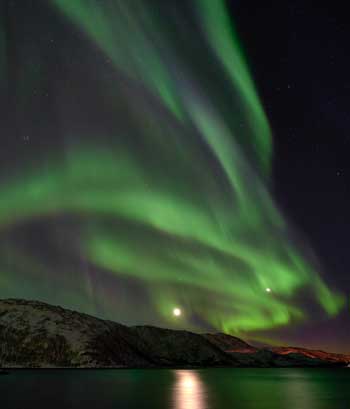FORECAST
When is The Best Time of Night to View the Northern Lights?
 Ah, the Northern Lights – those elusive, dancing curtains of colour that lure you out into the freezing cold with the promise of a once-in-a-lifetime experience. But when, exactly, is the best time to see them? The truth is, Aurora Borealis likes to play hide-and-seek, especially when it comes to revealing its most dazzling displays. You’ll need patience, persistence, games and snacks to survive a night of aurora chasing.
Ah, the Northern Lights – those elusive, dancing curtains of colour that lure you out into the freezing cold with the promise of a once-in-a-lifetime experience. But when, exactly, is the best time to see them? The truth is, Aurora Borealis likes to play hide-and-seek, especially when it comes to revealing its most dazzling displays. You’ll need patience, persistence, games and snacks to survive a night of aurora chasing.
This might seem a little obvious but the best time to catch the Aurora Borealis is at night when they are out overhead, duh. You'll want to find dark, clear skies with stars visible to the north - this is your baseline requirement and what follows are the active conditions and some luck. If you are in a location where auroras are common, then luck will come easy and if you are further south you will need more patience and persistence if you are to be so lucky.
Are You a Night Owl?
Good news for all you night owls out there – the Northern Lights are your perfect excuse to stay up way past your bedtime. The best time to catch them is usually between 10pm to 2am – 2 hours in either side of midnight. Yep, that’s right, prime aurora viewing hours are smack in the middle of the night. So, forget about beauty sleep; the only thing you’ll be catching is a glimpse of those glorious lights, if you’re lucky.
And let’s be clear, when we say 10pm to 2am, we mean every hour in between. This isn’t a “check the sky once and go back to bed” situation. You’re going to need dedication, caffeine, and possibly some warm, fuzzy mittens to keep you going.
Technically, watching for auroras for 2 hours on either side of solar midnight is more ideal. To find solar midnight where you are, take the current sunset and sunrise times and split the difference. Depending on your location and whether you’re in daylight savings time this could be significantly different than 10pm to 2am. Frankly, don't get too stuck on this as it is one of those "close enough, is good enough" situations - don't overthink it and just get out there.
Early Evening? Dream On.
Sure, it’s possible to see the Northern Lights earlier in the evening, say around 8 or 9pm, especially during peak aurora season (late fall to early spring). But let’s be real, Mother Nature rarely makes things that easy. If you’re one of those people who likes to be in bed by 10, you might want to adjust your expectations. Or, you know, resign yourself to watching aurora videos on YouTube.
Midnight Magic: The Witching Hour of the Auroras
Solar midnight is around where the big magic happens, or so they (we, err me) say. By this point, you’ve been outside long enough that your nose is frozen, you’ve questioned all your life choices, and you’re starting to wonder if this whole aurora thing is just a myth. But hang in there, because midnight is prime time. The Northern Lights love to put on their best performance right around this hour, often peaking in intensity and colour. If you’ve looked at an auroral map, you’ll note that this is around the time when the band is the fattest overhead.
The 2am Dilemma: To Sleep or Not to Sleep?
Now, here’s the kicker, sometimes the Northern Lights like to show up fashionably late, well past 2am. By this time, you’re probably thinking, “Is this even worth it?” But remember, those who persevere are often rewarded with the most stunning displays. It’s the universe’s way of testing your commitment. Just when you’re about to throw in the towel, the sky might explode with colour, and you’ll forget all about how tired you are. For a few minutes, anyway.
The Northern Lights Have a Mind of Their Own
The Northern Lights have their own schedule, and they couldn’t care less about your sleep cycle. Some nights, they’ll put on a show at 11pm, other nights, they’ll make you wait until the crack of dawn. And then there are those special nights when they decide not to show up at all, leaving you cold, tired, and questioning why you didn’t just stay in and watch Netflix.
But when you do finally catch them, all those late nights and freezing toes will be worth it. There’s nothing quite like standing under a sky that’s alive with colour, knowing you were in the right place at the right time, even if that time was 3:15m.
So, Embrace the Chaos
When is the best time of night to view the Northern Lights? The honest answer is whenever they feel like showing up. If you’re willing to brave the cold, lose some sleep, and maybe even develop a caffeine dependency (like you don’t already have one), then you’re well on your way to becoming an aurora aficionado. Remember, Mother Nature likes to keep things unpredictable, but that’s all part of the adventure.
So, grab your thermos, your patience, and your sense of wonder. If you are lucky, you’ll be in for a wild (and possibly very late) night!